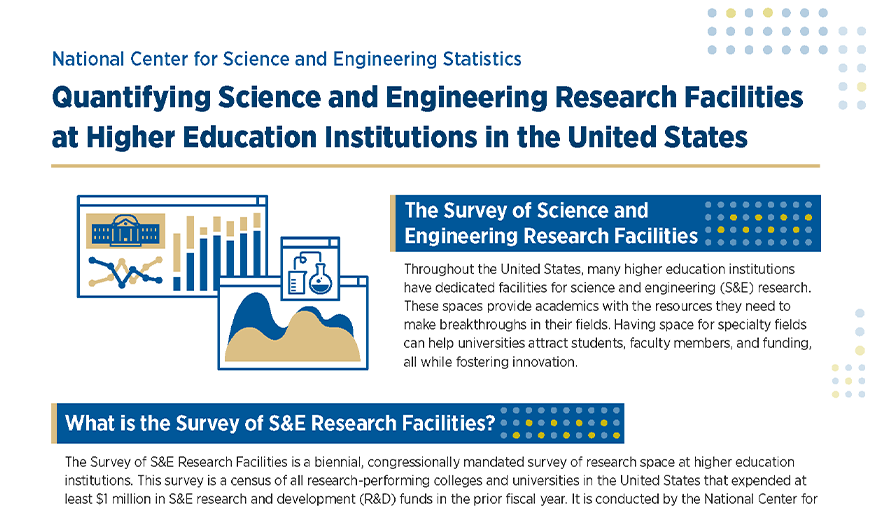Completion costs include planning, site preparation, construction, fixed equipment, nonfixed equipment that costs $1 million or more, and building infrastructure, such as plumbing, lighting, air exchange, and safety systems either in the building or within 5 feet of the building foundation.
Current research program commitments include current faculty and staff (or those to whom offers have been made or grants awarded, regardless of whether research has begun) and programs that have been approved.
Deferred projects are those that (1) are not funded and (2) are not scheduled for FY 2022 or FY 2023. They do not include projects planned for developing new programs or expanding current programs. Deferred projects are limited to only those projects whose prorated cost was estimated to be $250,000 or more for at least one field of S&E.
Gross square feet (GSF) is the floor area of a structure within the outside faces of the exterior walls.
Institutional control is defined for academic institutions as private or public.
Institutional funds and other sources include the following examples: operating funds, endowments, tax-exempt bonds and other debt financing, indirect costs recovered from federal grants or contracts, and private donations.
Medical school is a school that awards a doctor of medicine degree or a doctor of osteopathic medicine degree.
Net assignable square feet (NASF) is the sum of all areas on all floors of a building assigned to, or available to be assigned to, an occupant for a specific use, such as research or instruction. NASF is measured from the inside faces of walls.
New construction is the construction of a new building or additions to an existing building. New construction is limited to only those projects whose prorated cost was estimated to be $250,000 or more for at least one field of S&E.
Repairs and renovations are activities such as fixing up facilities in deteriorated condition, capital improvements on facilities, conversion of facilities, and building out shell (unfinished) space. They include any repairs or renovations to existing space that are performed in combination with new construction projects. They do not include building additions, which are reported in this survey under new construction. Repairs and renovations are limited to only those projects whose prorated cost was estimated to be $250,000 or more for at least one field of S&E.
Research is all research and experimental development (R&D) activities of an institution that are separately accounted for. These R&D activities comprise creative and systematic work undertaken to increase the stock of knowledge—including knowledge of humankind, culture, and society—and to devise new applications of available knowledge. This research can be funded by an institution, the federal government, a state government, foundations, corporations, or other sources.
Research space is the NASF of space in buildings within which research activities take place. Research facilities are located within buildings. A building is a roofed structure for permanent or temporary shelter of persons, animals, plants, materials, or equipment. Structures should be included if they are (1) attached to a foundation, (2) roofed, (3) serviced by a utility, exclusive of lighting, and (4) a source of significant maintenance and repair activities.
- Research space includes controlled-environment space, such as clean, cold, or white rooms; technical and laboratory support space, such as equipment areas, preparation areas, darkrooms, carpentry and machine shops, and storage areas; laboratories, including computer labs and behavior observation rooms; core laboratories that serve other laboratories; laboratories and associated support areas used for research animals, including procedure rooms, bench space, animal production colonies, holding rooms, germ-free rooms, surgical facilities, and recovery rooms; housing facilities for research animals and associated maintenance areas, including cage rooms, stalls, wards, isolation rooms, exercise rooms, feed storage rooms, cage-washing rooms, and holding and storage areas; space for clinical trial research; offices, to the extent that they are used for research activities, including administrative activities for a specific research project; space with fixed (built-in) equipment, such as fume hoods; space with nonfixed equipment costing $1 million or more each, such as MRI equipment; and space that is leased by the responding institution.
- Research space does not include space for the fields of law, business administration and management, humanities, history, the arts, or education; libraries, unless they are dedicated to a specific research project; animal field buildings sheltering animals that do not directly support research or that are not subject to government regulations concerning humane care and use of laboratory animals; FFRDCs; in-kind space used by faculty, staff, or other persons from the institution but administered by other organizations, such as research facilities at non-university hospitals or VA hospitals; space administered by the institution but leased to another organization; and outdoor areas, such as fish ponds or planting fields.
- Question 2 contains the following additional information about research space: research space is equivalent to functional category 2 (Research) for facilities inventory systems based on the U.S. Department of Education Facilities Inventory and Classification Manual (FICM classification), the Western Interstate Commission for Higher Education (WICHE classification), and the National Association of College and University Business Officers (NACUBO classification).
 An official website of the United States government
An official website of the United States government


